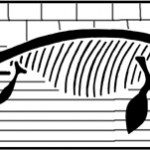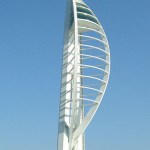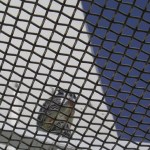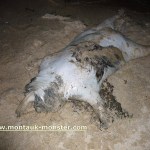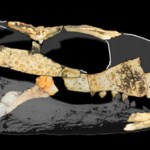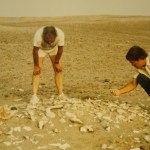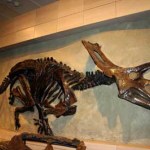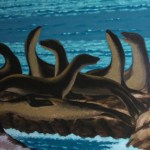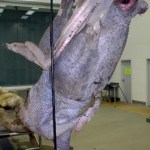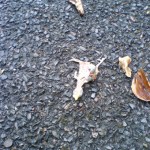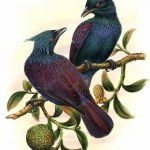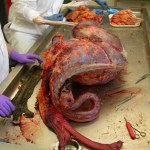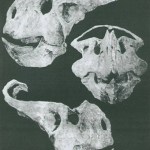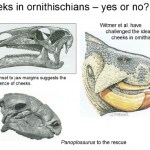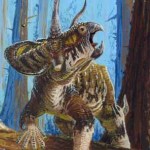It might not be well known outside of palaeontology that the south-west of England is famous for its marine reptile fossils. But it is: some of the best, most historically significant, plesiosaur and ichthyosaur specimens have come from Street in Somerset and from Lyme Regis and Charmouth in Dorset.
These rocks - spanning the Triassic-Jurassic boundary and known collectively as the Lower Lias - yield the giant, robust-skulled ichthyosaur Temnodontosaurus, the swordfish-like Leptonectes and Eurhinosaurus, and the more familiar, dolphin-like Ichthyosaurus. The long-necked plesiosaurs…

I try not to under-estimate the intelligence of my readers, but couldn't you be just a little more clueless? I mean, come on: virtually every person who left a comment realised that the 'mystery animal' from yesterday was a replica owl. Clearly, it was much, much easier than I thought. Anyway, well done everyone.
These owls are mostly based on Great horned owls Bubo virginianus, but the colour schemes are often a bit weird: the one I photographed has a red chest, though I doubt if this sort of thing makes much difference (hmm, or does it?). What's amusing is that this particular decoy is at…
Last weekend I went out, and saw this. What could it be?
Warning: this is not meant to be easy. Answer tomorrow.
Ever one to jump on a bandwagon, and with another 'mystery carcass' case still all too fresh on the Tet Zoo list of articles, I've decided to blog about this new 'Montauk monster' carcass. In case you've forgotten, back in July 2008 the global media went absolutely apeshit over a rotten raccoon carcass, informally dubbed the 'Montauk monster', and suggested by the uninformed to be some weird genetic experiment, a dead turtle without its shell (duh: THE SHELL IS THE RIBCAGE, IT CANNOT BE MAGICALLY DETACHED FROM THE REST OF THE BODY), or some sort of beaked dinosaur-monster. Yes, if you ever…
In the previous post we looked at the small, island dwelling crocodilians of the south-west Pacific. I personally find it exciting that such animals were (in the case of at least some of the species) alive until just a few thousand years ago, that they were encountered by people, and that their remains have eluded detection until recent decades. The odds are high that further species await discovery. Here's another article that originally appeared at Tet Zoo ver 1.
Before we get to the new stuff, here's something relevant to the mekosuchine article: a never-before-seen skull reconstruction…
Here's an interesting contention: until just a few thousand years ago, small crocodilians inhabited the tropical islands of the South Pacific and elsewhere. In fact, judging from recent discoveries, small terrestrial crocodilians were an ordinary component of many tropical island groups, and they presumably still would be, had they not been made extinct by people. This article originally appeared in 2006 on Tet Zoo ver 1, and here it is again...
The first of these animals to be discovered was Mekosuchus inexpectatus from New Caledonia (life restoration shown above), a species that most…
It is with some sadness that I must pass on the news that Cyril Walker died last Wednesday (6th May 2009). Cyril worked at the Natural History Museum from 1958 until his retirement in 1999. He is best known for his many palaeornithological contributions: often working together with his colleague Colin Harrison (1926-2003), he produced numerous papers on fossil birds from all around the world. Among the more noteworthy of these are the pelagornithid review (Harrison & Walker 1976a) and the Prophaethon reappraisal (Harrison & Walker 1976b). Cyril also contributed to Charig et al. (1986…
Yet again I became distracted the other day, this time by that 'Jaws' photo. The previous article is required reading. Thanks to everyone who provided comments, and had a go at identifying the carcass. While many people suggested 'short-faced dog', a cat identification seems to have been more popular. Time to try to provide some answers...
What can we see from the one existing photo? First off, this animal definitely has small incisors, large canines, and then an assortment of post-canine teeth. This combination immediately rules out loads of possible contenders, most notably diprotodontian…
The Australian mainland's largest extant native mammalian predator is the Spotted-tailed quoll or Tiger quoll Dasyurus maculatus. It weighs, at most, 7 kg. While rumours of Thylacine Thylacinus cynocephalus (15-30 kg) survival persist both in Tasmania and on the Australian mainland (and, incidentally, in New Guinea too), no compelling evidence has yet been presented which might demonstrate survival to recent decades (though there is at least some suggestive evidence). It has been claimed by some that Tasmanian devils Sarcophilus harrisii (maximum weight 11.8 kg) might also still be extant on…
A little while ago - that is, during Ceratopsian Week - I discussed NMC 8538, the excellent articulated Anchiceratops ornatus specimen today displayed at the Canadian Museum of Nature in Ottawa. Alas, while photos of the panel-mounted specimen were published by Lull (1933) and also by David Norman in his The Illustrated Encyclopedia of Dinosaurs, they're small and I don't have access to hi-res versions. Well, today we owe a substantial debt of gratitude to ReBecca Hunt-Foster of Dinochick Blogs for - ta-dah! - heeeeeeere's NMC 8538....
As mentioned before, the specimen shows that…
Yesterday, Tet Zoo was the featured blog on the Nature Blog Network blog: if you haven't seen the interview please do check it out here.
NBN is well known to most bloggers who write about the natural world: it's a ranked network of blogs, all of which are united by the fact that they focus on animals, ecosystems, or outdoorsy stuff in general [the accompanying picture shows the Miocene phocid Acrophoca longirostris as featured in a mural at the SMNK in Karlsruhe. Image kindly provided by Markus Bühler. The image is irrelevant to the current article, but what the hey. Weird long-necked…
After last week's look at an emu dissection, it seemed only logical to follow up with dissection pics of another ratite. So when John Hutchinson of the Royal Veterinary College (RVC) mentioned his dissection photos of Ozbert the ostrich, I asked politely, and received. Note that all photos are © John Hutchinson and Jason Moore, and are used with permission. Ozbert's suspended cadaver is shown here [note the gigantic calf muscles and extruded phallus].
Ozbert, donated by a British ostrich farm, was huge, tipping the scales (when plucked) at 129 kg (the world record is supposedly 160 kg) […
Here is a mystery I'd really like to know the answer to. On the way to school this morning, Will discovered a dead baby bird. Here it is: the photo (which I took on my phone) is atrocious, so there's little point in showing it at larger size. Clearly, this is an altricial, nidicolous passerine chick, probably of a Blackbird Turdus merula. The question is: how does an altricial nestling like this - barely able to walk in its own nest, least of all out of it - get to be dead in the middle of the pavement? No, it didn't fall out of its nest, because there were no overhanging trees or bushes…
As you'll know if you've already seen the announcement over at SV-POW!, my friend and co-author Mike P. Taylor successfully defended his Ph. D. yesterday: congratulations again, Mike. Mike's thesis was titled Aspects of the History, Anatomy, Taxonomy and Palaeobiology of Sauropod Dinosaurs: its contents (listed here) will soon see publication; indeed, some chapters are already published (Taylor & Naish 2007) or in press.
Here, Mike shakes hands with Eric Buffetaut (his external examiner) while a very jovial Andy Gale (his internal examiner; he looks suspiciously like Eddie Izzard in this…
Inspired by comments made following the emu dissection article from Monday, I got thinking about elongate tracheae in birds. As we'll see, this subject is fertile ground if you like serious weirdness and spectacular extremes [Trumpet manucodes shown here, from wikipedia.. all will become clear]. Before we get to that serious weirdness and those spectacular extremes, a bit of basic anatomy...
The trachea - or windpipe - is, as I'm sure you already know given that you've got one, a tube that extends along the ventral surface of the neck from the larynx to the lungs [singular: trachea, plural:…
Back in 2006 my good friend Matt Wedel - who you may know better as one of the three SV-POWsketeers or as plain old Dr Vector - produced a short article on an emu dissection he participated in at the University of California at Santa Cruz [adjacent image: an Emu Dromaius novaehollandiae... though note that this one is very much alive and not involved in any way in the photos you are about to see].
Because I like talking about ratite anatomy, I've been meaning for ages to steal borrow showcase Matt's photos here at Tet Zoo. Finally, I'm doing it now (with his permission), better late than…
I never planned to do a whole week on ceratopsians: the initial idea was just to recycle some of those field guide texts in order to save a bit of time. But, oh well, Ceratopsian Week took on a life all its own. To finish things off, we're going to look at some tremendously obscure ceratopsians: they're reasonably familiar to dinosaur uber-nerds/dinosaur experts, of course, but are unheard of outside of the dinosaur community.
We begin with Protoceratops hellenikorhinus Lambert et al., 2001 [shown here] from the Campanian of Bayan Mandahu, Inner Mongolia. P. hellenikorhinus is similar to the…
What with yesterday's article on an 'alternative look' for ceratopsians, here's another one. The image used here (again, a powerpoint slide from one of my talks) is pretty self-explanatory, and I use it here because Witmer and colleagues (Papp 1997, Papp & Witmer 1998) used the leptoceratopsid ceratopsian Leptoceratops as their examplar...
Did Leptoceratops (and other ceratopsians, and other ornithischians) really look like this? That is, with keratinous tissue extending along the jaw margins and 'cheeks' being absent (and by 'cheeks' I mean sheets of tissue enclosing the lateral…
One of the most distinctive features of ceratopsian dinosaurs is the conspicuous bony frill, formed from the parietal and squamosal bones, that projected backwards (and sometimes upwards too) from the rear margin of the skull.
Typically decorated around their edges by semi-circular bones called epoccipitals, and sometimes sporting horns, spikes or mid-line keels, frills were a fundamental part of the skull: this means that, whenever the animal moved its head up, or down, or to the side, the whole frill moved too. The fact that the ceratopsian occipital condyle is damn-near spherical shows…
So far we've looked at leptoceratopsids and chasmosaurine ceratopsids. This time, it's the turn of the basal ceratopsoid Zuniceratops. If these terms are giving you grief, a cladogram showing a few of them is below...
Zuniceratops christopheri [adjacent life restoration by Todd Marshall] was named in 1998 by Douglas Wolfe and Jim Kirkland for several specimens discovered in the Turonian Moreno Hill Formation of New Mexico. Its generic name honours the Zuni people, while its specific name is for Christopher Wolfe, co-discoverer of the first specimen. In many features Zuniceratops was…
